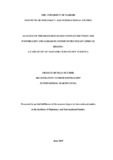| dc.description.abstract | Many African countries are dependent basically on agriculture (crop and livestock
farming) as their main economic activity. Since Kenya gained independence in
1963 they have been increasing tension between the crop farmers and herders.
Such tensions at times generated into violent conflicts resulting in loss of lives and
properties. In Naivasha region, the Maasai and Kikuyu communities use land in
the region for crop production as well as dry season grazing for herders. This has
created conflict in the region between the two communities. The study therefore
sought to analyze resource based conflict between the pastoralist and agrarian
communities in East Africa Region with a case study of Naivasha Region in
Kenya. Specific objectives were to: determine the dynamics of conflict between
pastoralists and crop farmers in Naivasha Sub-County; assess the effects of the
conflict between crop farmers and pastoralists in Naivasha Sub-County; and
establish ways through which ethnic conflict between pastoralists and crop
farmers in Naivasha Sub-County can be addressed. The study adopted descriptive
research design method. The target population was 1,603,325 residents with a
sample size of 150 residents. The study adopted purposive sampling technique to
sample the respondents. Both qualitative and quantitative data was collected from
the respondents. Data was analyzed using descriptive statistics and findings were
presented in graphs, tables, frequencies and percentages. The study found that
victims of ethnic violence in the Naivasha have been subjected to psychological
and emotional trauma. Although ethnic violence has led to an increase in social
distance between ethnic groups, inter-ethnic marriages have persistent. The study
found that some politicians, provincial administrators such as District Officers and
chiefs acquired some of the land designated for the resettlement of the displaced.
It found that conflict affected the Maasai both positively and negatively. When
they attacked, they gained land and property while when they were attacked they
lost land and property. It found that land is the major factor in the conflicts
happening in Naivasha and in the process of the fight for these lands a lot of lives
are lost. The study lastly found that local authority/government can stop the
conflicts by taking action through condemning the conflicts and apprehending the
culprits. It found that the police also can help in stopping the conflict but it was
noted that the police did little if anything, during the conflicts in Naivasha | en_US |

